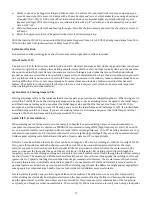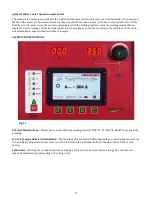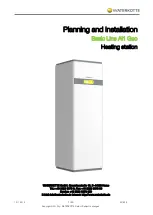
16
Now Let’s Talk Pulse
How does pulse work? How do I set up the Invertig 313/400 to pulse weld in Stick mode?
For manufacturing or critical code repairs, welding procedures are typically specified. These welding procedures spell
out everything including, but not limited to, pre-heat of the part, alloy of the filler rod, amperage setting, travel speed,
bead size, multi-pass weld number of passes (if applicable), inter-pass temperature, post-heat, and so on. No variable
stays undefined, and there is no room for creative freedom.
In the repair field, however, things look a little bit different. In Europe, procedures that spec pulse welding exist. But the
pulse welding process is relatively new in the U.S., so no written procedures that spec pulse welding currently exist. For
example, a 1/8” 7018 rod typically has an operating range between 90-160 amps. But many people like to run them
between 120 and 130 amps.
To pulse weld, the operator first sets the welding current and then chooses a pulse frequency. The machine
automatically sets the background current and a pulse-on time of 50%.
So what does that mean when you weld?
Let’s
say, for example, you dialed the machine in to 130 amps. 50% of the time the arc is lit, the welding current is 130 amps.
The other 50% of the time the arc is lit, the welding current is 65 amps. You may notice that 65 amps is outside of the
manufacturer’s recommended amperage range. While the background current is on, the amperage is high enough to
maintain an arc but low enough to where there is no metal transfer happening.
The benefit of this is especially apparent at very low frequencies (1 to 1.5Hz). The out-of-range background current
allows the puddle to cool down and also allows the weld to partially solidify around the edges. This makes out-of-
position gap bridging on poor fit up much easier than it is with a classic stick welder. You will not sacrifice any
penetration because, during the 50% on time at 130 amps, the rod burns as hot and deep as it normally would on a
classic stick welder at 130 amps.
This may prompt you to ask:
If the amperage range of the rod is 80 or 90 to 160, why not set the welding current at 160
amps so the Invertig sets the background current to 80 amps?
The amperage ratings, essentially, would be well
within the specs then. This is absolutely possible and a good setting. However, this setting is very hot and metal transfer
occurs the entire time. This, paired with a 3 to 4Hz pulse frequency, makes for a very high travel speed in the horizontal
or flat position. Plus, the heat input into the work piece is enormous.
Knowing what we know now, let’s go back to the beginning and look more closely at the advantages of pulse welding.
Pulse welding includes ALL of the following advantages, but
not all at the same time
.
Visually spatter free (MIG & TIG only, though still reduced spatter when stick welding)
Higher travel speeds—
As just covered, with the right settings, the travel speed can be greatly increased.
Deeper penetration—
If you choose the same or similar settings to the ones for a higher travel speed, the overall heat
input and penetration increases also.
Less heat input, which equals less material distortion—
More like the first example about setting the welding current
to 130 amps.
Ability to weld thinner material than you could without pulse—
To achieve this, you would reduce the max amperage
even more. For example, 110 amps or 120 amps with a 55 amp background current, which makes for an average heat
input of roughly (110 + 55)/2 = 82.5 amps. (The actual heat input may be somewhat higher, especially with higher
pulse frequency settings). With this setting, you can weld materials with a 1/8” rod when you would normally need to
weld with a 3/32” rod.
Superior control of the weld puddle, especially when welding out of position—
You have better control on lower pulse
frequencies because the puddle has time to partially solidify.
Easily join materials of differing thicknesses—
More like the first example about setting the welding current to 130
amps.
Better gap bridging when welding materials with poor fit up—
More like the first example about setting the welding
current to 130 amps.
Ability to make leak-tight welds—
Spray arc or stick welding arc, in general, works better at making leak tight welds
than short arc MIG, for example.
Improved bead appearance—
Pulse welds, especially lower frequency pulse welds (2Hz or less) make really nice and
defined ripples on the top of the weld bead; welds like this are generally thought to be aesthetically appealing.
















































